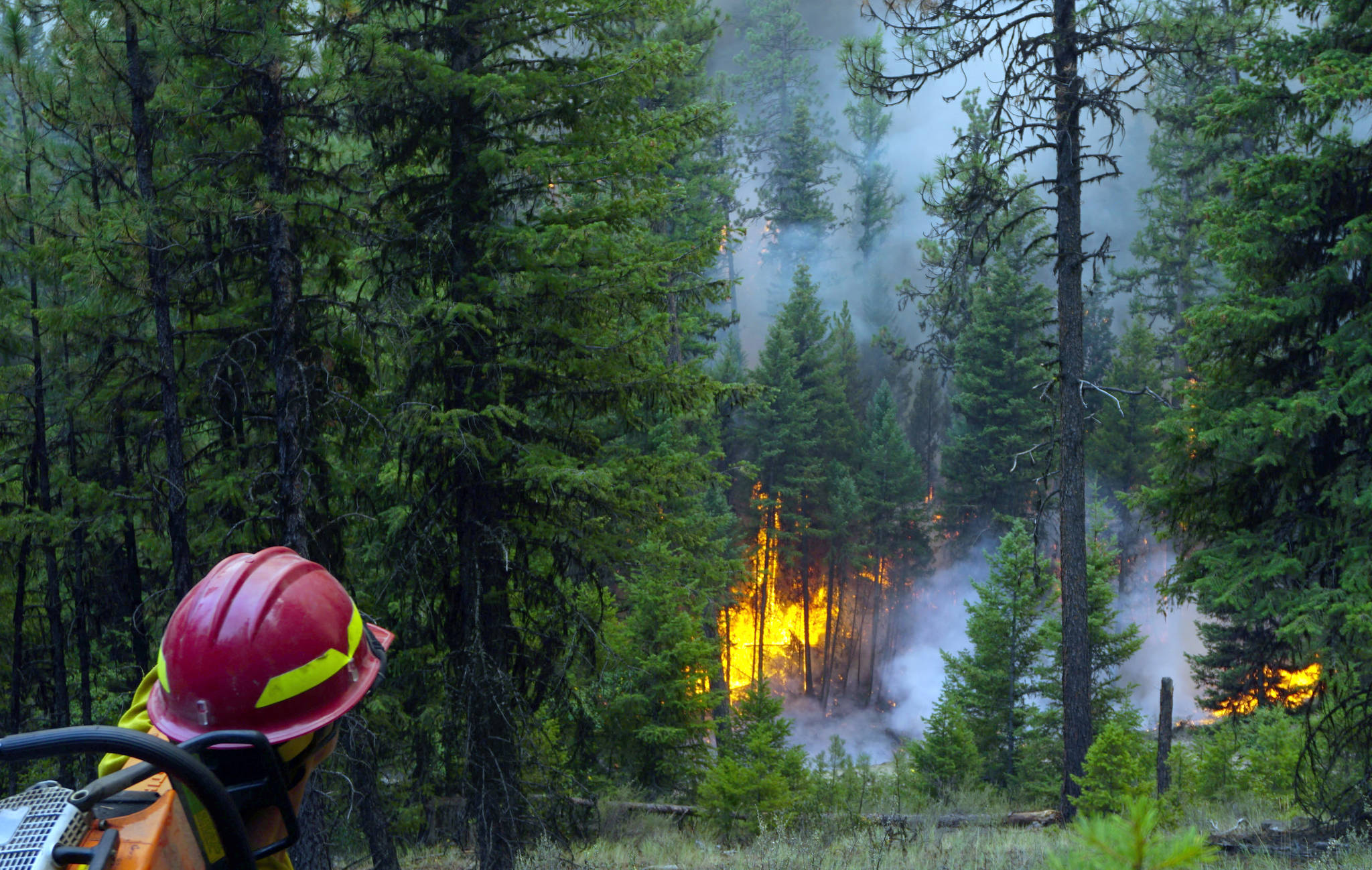By ALLIE CUNNINGHAM
Let’s go back to the beginning.
On a day in late August 2016, I found myself on a steep slope in Lolo National Forest near Plains, Montana. I had a Stihl MS038 on my shoulder, and I was listening intently to my hand-held radio. About 500 feet below me on the opposite side of a logging road, a hotshot crew was conducting a burnout operation.
Burnouts have many functions. In this case, it was a mitigation strategy — the burnout created a piece of “solid black” — allowing the main fire to work its way steadily downhill without putting containment lines at risk.
Or, at least, that was the plan. I was tasked with “spinning” weather and reporting my findings to the division supervisor. During critical operations, such as firing, fire personnel take weather observations at least every hour, including relative humidity measurements with a sling psychrometer.
Burning conditions transitioned from favorable to a little too favorable in just a few hours. As a “holding” resource, we were standing in unburned vegetation across the road from the burnout operation, extinguishing any embers that crossed into the “green.” This is a vulnerable position, as any fire that crossed the road could jeopardize our safety.
It was 1500, the middle of the critical burn period when fires spread most rapidly. Over the radio came a warning to all fire personnel — a thunder cell had formed over Plains and was expected to impact the fire area within thirty minutes. Wind gusts could reach 45 mph. The relative humidity values would plummet ahead of the cold front.
We heard this. We kept watch — as did the Bitterroot Hotshots below us on the hill.
A few minutes later we felt the winds pick up as the cell passed over. Trees began torching in groups and embers were blown far across the logging road below. Someone on the road found a spot fire ahead of us, in the green. Bitterroot moved to the road and we followed.
Our crew boss counted personnel as we lined out, giving instructions to hike up the road to a safety zone identified earlier in the day. My squad boss led the crew. In that moment, my chain saw seemed to weigh only 10 pounds instead of its usual thirty. We reached the safety zone in minutes and circled up to take our collective breath.
This was the moment that I caught “the fire bug.” There have been many others since then, with varying levels of intensity. Needing to escape to a safety zone is not commonplace. This one sticks in my memory as the first of many times that we leaned upon a network of trust and communication. Our foundation was tested … and it held.
I fought fire as a member of the Kenai National Wildlife Refuge trail crew for two seasons before the opportunity arose to turn collateral work into primary duty. The Wildland Firefighter Apprenticeship Program was started in 1989 with staff from the U.S. Forest Service and Bureau of Land Management. Although the National Park Service and U.S. Fish and Wildlife Service also partnered in 1997, I am the first wildland firefighter apprentice for the Fish and Wildlife Service!
The Wildland Firefighter Apprenticeship Program is an educational and experiential program designed to develop future fire and aviation managers. The program accomplishes this task by utilizing training, education and paid work experience to take an entry-level wildland firefighter to the “journey-level,” orcertified Firefighter Type 1.
The training and education include up to two academies hosted each spring and fall, as well as on-the-job training through six required experience categories. These categories span fireline suppression duties (engines, dozers, handcrews, aviation) to time in dispatch, wildland fire prevention/education, local unit planning and preparedness, fuels management, fire business practices and wildland fire safety.
The academies consist of classes that support progression in fire management through both fireline (field) duty qualifications and leadership skills. Apprentices are also held to a national fitness standard, expected to meet the minimum of 25 pushups, 45 situps, two to seven pullups, and a 1.5-mile run in 10.5 minutes. Each calisthenic must be completed within three minutes. The Work Capacity Test (aka pack test) is also required at “arduous” level: Three miles in 45 minutes with a 45-pound weight vest.
In a nutshell, the Wildland Firefighter Apprenticeship Program is like going to college for a degree in wildland fire but being paid to do so. At the Kenai refuge, this is a term position, which means I work year-round for up to four years while I progress through the program.
When I’m not fighting fire, I work at refuge headquarters maintaining our fire caches and chain saws, assisting with fuels work, collecting vegetation data from the Sterling fuel break, helping other refuge programs like trails and cabins, and a myriad of other things.
We have a unique situation at the Kenai refuge, as most of our fuels work is completed in the winter rather than summer. We typically burn piles of slash derived from other thinning projects accomplished by hand or machine. It will be an adjustment for this lifelong seasonal worker to relinquish some of my former adventure time to working time, but it is part of the path and I will do my best to accept the change gracefully.
I have the fire bug, after all.
Alexandra “Allie” Cunningham is a Wildland Firefighter Apprentice at Kenai National Wildlife Refuge. Find more Refuge Notebook articles (1999-present) at https://www.fws.gov/Refuge/Kenai/community/Refuge_notebook.html.

